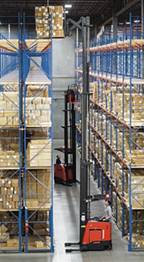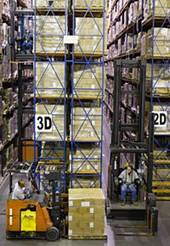One of the most basic planning decisions relative to pallet rack layout is the width of the lift truck aisles. Do you want to use a conventional; a narrow-aisle (NA); or a very-narrow-aisle (VNA); rack configuration? The following is a brief overview of what each approach has to offer.
Conventional: Conventional pallet rack layouts typically use aisle widths of 12 feet, and are usually no more than 4 pallets high permitting the use of standard counterbalanced fork lift trucks. To translate this into storage positions, 1,000 pallets will require about 10,500 sq. ft. of floor space.
 Narrow Aisle (NA): By choosing to go with a narrow-aisle (NA) layout, you will be able to store the same 1,000 pallets in about 6,000 sq. ft. of floor space, which equates to a savings of about 40%. This is because the NA layout utilizes a specially designed compact Reach Truck that can stack pallets 6 high while operating in an 8 ft. wide aisle. The Reach Truck is equipped with a pantograph type of reach mechanism that scissors the pallet forward from the mast. In operation, the truck turns a right angle to face the rack, and then extends the pallet load out into its proper slot. Due to the truck’s compact overall length and the fact that it carries its forks in a retracted position, it requires substantially less room to turn than does a conventional counterbalanced fork lift truck. Narrow Aisle (NA): By choosing to go with a narrow-aisle (NA) layout, you will be able to store the same 1,000 pallets in about 6,000 sq. ft. of floor space, which equates to a savings of about 40%. This is because the NA layout utilizes a specially designed compact Reach Truck that can stack pallets 6 high while operating in an 8 ft. wide aisle. The Reach Truck is equipped with a pantograph type of reach mechanism that scissors the pallet forward from the mast. In operation, the truck turns a right angle to face the rack, and then extends the pallet load out into its proper slot. Due to the truck’s compact overall length and the fact that it carries its forks in a retracted position, it requires substantially less room to turn than does a conventional counterbalanced fork lift truck.
A variation of this truck design is the double-reach, which uses a double pantograph mechanism to increase the length of its reach. A double-reach truck can store pallets two-deep, permitting you to use double-deep rows of rack. Double-reach trucks require an additional 6” of aisle width for their turns (8’-6” total). With this layout you’ll only need 4,500 sq. ft. to accommodate 1,000 pallets.
 Very Narrow Aisle (VNA): If you need to squeeze even more storage capacity out of your warehouse you should consider a very-narrow-aisle (VNA) rack layout. With VNA storage you can narrow the aisle widths down to 5’-6” or even less, while increasing rack heights to as many as 9 slots (40 feet.) Very Narrow Aisle (VNA): If you need to squeeze even more storage capacity out of your warehouse you should consider a very-narrow-aisle (VNA) rack layout. With VNA storage you can narrow the aisle widths down to 5’-6” or even less, while increasing rack heights to as many as 9 slots (40 feet.)
Now you’ll need just 3,200 sq. ft. of floor space to store 1,000 pallets. However, VNA requires a highly specialized rack-guided or wire-guided Swing-Reach Turret Truck. However, the price reflects their sophisticated designs and performance capabilities.
In addition, your aisle floor must be “super flat”. There are concrete floor specialists that work with contractors to pour a super flat floor for new construction and/or provide corrective concrete floor laser grinding in existing buildings.
The type of pallet storage rack, the rack layout, and the type of lift truck should all be selected based on the storage and throughput requirements of your operation and the uniqueness of your building.
Agree or disgree with our expert's perspective? What would you add? Let us know your thoughts for publication in the SCDigest newsletter Feedback section, and on the website. Upon request, comments will be posted with the respondent's name or company withheld.
|